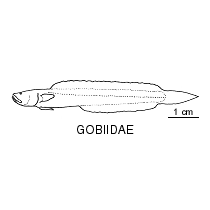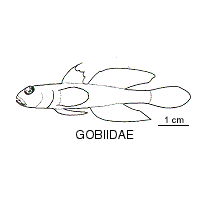- Classification
- ACTINOPTERYGII
- PERCIFORMES
- GOBIIDAE
-
Fish Classification
-
Class
ACTINOPTERYGII Ray-finned fishes -
Order
PERCIFORMES Perches and allies -
Family
GOBIIDAE Gobies -
Genera
Acanthogobius(1) Acentrogobius(4) Afurcagobius(2) Amblyeleotris(18) Amblygobius(8) Amblyotrypauchen(1) Amoya(3) Apocryptodon(2) Arcygobius(1) Arenigobius(3) Asterropteryx(6) Austrolethops(1) Awaous(2) Barbuligobius(1) Bathygobius(8) Boleophthalmus(2) Brachyamblyopus(1) Bryaninops(10) Cabillus(5) Callogobius(8) Caragobius(2) Chlamydogobius(6) Cristatogobius(1) Cryptocentroides(2) Cryptocentrus(15) Ctenogobiops(6) Ctenotrypauchen(1) Discordipinna(1) Dotsugobius(1) Drombus(7) Echinogobius(1) Egglestonichthys(2) Eugnathogobius(3) Eviota(41) Exyrias(3) Favonigobius(5) Feia(2) Fusigobius(9) Glossogobius(10) Gnatholepis(6) Gobiodon(18) Gobiopsis(5) Gobiopterus(2) Grallenia(3) Hazeus(3) Hemigobius(1) Hetereleotris(1) Istigobius(9) Kelloggella(1) Larsonella(1) Lobulogobius(2) Lotilia(1) Lubricogobius(2) Luposicya(1) Macrodontogobius(1) Mahidolia(1) Minysicya(1) Mugilogobius(9) Myersina(2) Nesogobius(10) Obliquogobius(1) Oligolepis(1) Oplopomus(2) Oxyurichthys(6) Paedogobius(1) Palutrus(1) Pandaka(2) Parachaeturichthys(1) Paragobiodon(6) Paratrypauchen(1) Parkraemeria(1) Periophthalmodon(1) Periophthalmus(8) Phyllogobius(1) Pleurosicya(12) Priolepis(13) Psammogobius(2) Pseudogobius(9) Psilogobius(1) Redigobius(5) Scartelaos(1) Schismatogobius(1) Sicyopterus(2) Sicyopus(1) Signigobius(1) Silhouettea(3) Smilosicyopus(2) Stiphodon(4) Stonogobiops(2) Sueviota(3) Taenioides(4) Tasmanogobius(3) Tomiyamichthys(8) Tridentiger(1) Trimma(32) Trimmatom(6) Trypauchenichthys(1) Valenciennea(13) Vanderhorstia(7) Yoga(1) Yongeichthys(1)
Family GOBIIDAE
The family Gobiidae is the largest family of marine fishes, with more than 1700 described species in more than 260 genera (Eschmeyer & Fong 2013) - representing almost 10% percent of all fish species. More than 90 genera and 330 described species are found in Australian waters.
Gobies are mostly small, bottom-dwelling cryptic fishes with pelvic fins usually united into a cup-shaped disc positioned below or just behind the pectoral-fin bases, two separate dorsal fins, and no lateral line.
They are abundant worldwide in tropical to temperate marine, estuarine and freshwater environments, mostly on the continental shelf, but also on the continental slope to depths below 1100 m. Some live above the high tide on mudflats, some build elaborate burrows, some live only in caves, others live inside sponges or on corals, and some freshwater species are able to climb waterfalls.
Gobies have a variety of reproductive modes and some are hermaphroditic, changing sex throughout their life cycle. Adults range in size from 1.5 to 50 cm TL, although most are 3-10 cm in length.
More Info
|
Family Taxonomy |
The family Gobiidae is one of the largest fish families in the world, representing about 10 percent of all fish species. More than 230 genera and 1650 described species are recognised worldwide, and there are more than 90 genera and 330 described species known from Australian waters. Many species are still yet to be described. Larson & Murdy (2001) presented a key to genera from the western Pacific. Gill & Mooi (2010, 2012) determined that the genera previously included in the family Microdesmidae actually belonged in the Gobiidae. |
|
Family Distribution |
Gobies live in a wide variety of tropical and temperate environments worldwide, including coral reefs, estuaries, freshwaters and on the continental shelf to depths of over 900 m. Most are bottom-dwelling in shallow marine and estuarine habitats, although some pelagic species feed on plankton just above the bottom. Many gobies live on open sandy areas amongst reefs and construct burrows for protection. One group, the shrimp gobies, share their burrows with alpheid shrimps that constantly excavate and maintain extensive tunnels. |
|
Family Description |
Gobies are primarily small fishes, usually with pelvic fins fused into a cup-shaped disc and positioned below, or below and just behind the pectoral fin bases, two dorsal fins and no lateral line on the sides of the body. |
|
Family Size |
Small to medium-sized fishes, ranging from 1 to 50 cm, but to only 16 cm in Australia. Most species are 3-10 cm in length. |
|
Family Colour |
|
|
Family Feeding |
Gobies are usually bottom‑living fishes that prey on small invertebrates. Some species feed on zooplankton above the bottom. |
|
Family Reproduction |
The sexes are separate in most, and males and females often live in pairs. Some gobies undergo sex change during their lives. Although this is not unusual amongst fishes, some gobies can change sex from female to male and back to female again which is unknown in other fishes. Females lay demersal eggs that may be guarded by one or both parents, and the larvae are pelagic. |
|
Family Commercial |
Some gobies are very popular aquarium fishes. |
|
Family Conservation |
|
|
Family Remarks |
|
|
Family Biology |
|
|
Author |
Bray, D.J. 2017 |
|
Family Resources |
|
References
Akihito, P. 1986. Some morphological characters considered to be important in gobiid phylogeny. pp. 629-639 in Uyeno, T., Arai, R., Taniuchi, T. & Matsuura, K. (eds). Indo-Pacific Fish Biology. Proceedings of the Second International Conference on Indo-Pacific Fishes. Tokyo : Ichthyological Society of Japan 985 pp.
Birdsong, R., Murdy, E.O. & Pezold, F.L. 1988. A study of the vertebral column and median fin osteology in gobioid fishes with comments on gobioid relationships. Bulletin of Marine Science 42(2): 174-214 figs 1-5
Eschmeyer, W.N. & Fong, J.D. Species by Family/Subfamily. (http://research.calacademy.org/research/ichthyology/catalog/SpeciesByFamily.asp). Electronic version accessed 11 August 2013.
Gill, H.S., Bradley, F.L.S. & Miller, P.J. 1992. Validation of the use of cephalic lateral-line papillae patterns for postulating relationships among gobioid genera. Journal of the Linnean Society of London, Zoology 106: 97-114
Gill, A.C. & Mooi, R.D. 2010. Character evidence for the monophyly of the Microdesminae, with comments on relationships to Schindleria (Teleostei: Gobiidae). Zootaxa 2442: 51–59.
Gill, A.C. & Mooi, R.D. 2012. Thalasseleotrididae, new family of marine gobioid fishes from New Zealand and temperate Australia, with a revised definition of its sister taxon, the Gobiidae (Teleostei: Acanthomorpha). Zootaxa 3266: 41–52.
Harrison, I.J. 1989. Specialization of the gobioid palatopterygoquadrate complex and its relevance to gobioid systematics. Journal of Natural History 23: 325-353
Hoese, D.F. 1983. Sensory papilla patterns of the cheek lateralis system in the gobiid fishes Acentrogobius and Glossogobius, and their significance for the classification of gobioid fishes. Records of the Australian Museum 35: 223-229
Hoese, D.F. 1984. Gobioidei: Relationships. 588-591 in Moser, H.G. et al. (eds). Ontogeny and Systematics of Fishes. American Society of Ichthyologists and Herpetologists. Special Publication 1: 1-760
Hoese, D.F. & Larson, H.K. 1994. Revision of the Indo-Pacific gobiid fish genus Valenciennea, with descriptions of seven new species. Indo-Pacific Fishes 23: 1-71 11 figs, 6 pls
Hoese, D.F. & H.K. Larson. 2008. Family Gobiidae (pp. 749-773), in Gomon. M.F., Bray, D.J. & Kuiter, R.H (eds) 2008. Fishes of Australia's Southern Coast. Sydney : Reed New Holland 928 pp.
Hoese, D.F. & Randall, J.E. 1982. Revision of the gobiid fish genus Stonogobiops. Indo-Pacific Fishes 1: 1-18 figs 1-4 pls 1-3
Jewett, S.L. & Lachner, E.A. 1983. Seven new species of the Indo-Pacific genus Eviota (Pisces : Gobiidae). Proceedings of the Biological Society of Washington 96(4): 780-806 figs 1-13
Karnella, S.J. & Lachner, E.A. 1981. Three new species of the Eviota epiphanes group having vertical trunk bars (Pisces : Gobiidae). Proceedings of the Biological Society of Washington 94(1): 264-275 figs 1-6
Lachner, E.A. & Karnella, S.J. 1978. Fishes of the genus Eviota of the Red Sea with descriptions of three new species (Teleostei : Gobiidae). Smithsonian Contributions to Zoology 286: 1-23 figs 1-11
Lachner, E.A. & Karnella, S.J. 1980. Fishes of the Indo-Pacific genus Eviota with descriptions of eight new species (Teleostei : Gobiidae). Smithsonian Contributions to Zoology 315: 1-127 figs 1-66
Lachner, E.A. & McKinney, J.F. 1978. A revision of the Indo-Pacific fish genus Gobiopsis with descriptions of four new species (Pisces : Gobiidae). Smithsonian Contributions to Zoology 262: 1-52 figs 1-7 pls 1-11
Lachner, E.A. & McKinney, J.F. 1979. Two new gobiid fishes of the genus Gobiopsis and a redescription of Feia nympha Smith. Smithsonian Contributions to Zoology 299: 1-18 figs 1-11
Larson, H.K. 2001. A revision of the gobiid fish genus Mugilogobius (Teleostei: Gobioidei), and its systematic placement. Records of the Western Australian Museum, Supplement 62: 1-233
Larson, H.K. & Murdy, E.O. 2001. Eleotridae, Gobiidae. pp. 3574-3604 in Carpenter, K.E. & Niem, T.H. (eds). The Living Marine Resources of the Western Central Pacific. FAO Species Identification Guide for Fisheries Purposes. Rome : FAO Vol. 6 pp. 3381-4218
Larson, H.K. & Williams, R.S. 1997. Darwin Harbour fishes: a survey and annotated checklist. pp. 339-380 in Hanley, H.R., Caswell, G., Megirian, D. & Larson, H.K. (eds). The Marine Flora and Fauna of Darwin Harbour, Northern Territory, Australia. Proceedings of the Sixth International Marine Biology Workshop. Darwin : Museum and Art Gallery of the Northern Territory 466 pp.
Munday, P.L., Harold, A.S. & Winterbottom, R.W. 1999. Guide to coral-dwelling gobies, genus Gobiodon (Gobiidae) from Papua New Guinea and the Great Barrier Reef. Revue Française d'Aquariologie et Herpetologie 26: 53-58
Murdy, E.O. 1989. A taxonomic revision and cladistic analysis of the oxudercine gobies (Gobiidae: Oxudercinae). Records of the Australian Museum, Supplement 11: 1-93 figs 1-98 pls 1-3
Murdy, E.O. 2006. A revision of the gobiid fish genus Trypauchen (Gobiidae: Amblyopinae). Zootaxa 1343: 55-68
Murdy, E.O. & Hoese, D.F. 1985. A revision of the gobioid fish genus Istigobius. Indo-Pacific Fishes 4: 1-41 figs 1-8 pls 1-3
Patzner, R.A., J.L Van Tassell, M. Kovacic & B.G. Kapoor (eds). 2011. The Biology of Gobies. Taylor & Francis, 650 pp.
Pezold, F.L. 1993. Evidence for a monophyletic Gobiinae. Copeia 1993(3): 634-643
Randall, J.E. 1995. Fusigobius Whitley, a junior synonym of the gobiid fish genus Coryphopterus. Bulletin of Marine Science 56(3): 795-798
Randall, J.E. 2001. Five new Indo-Pacific gobiid fishes of the genus Coryphopterus. Zoological Studies 40(3): 206-225
Randall, J.E. & Greenfield, D.W. 2001. A preliminary review of the Indo-Pacific gobiid fishes of the genus Gnatholepis. Ichthyological Bulletin of the J.L.B. Smith Institute, Grahamstown 69: 1-17
Randall, J.E., Allen, G.R. & Steene, R. 1997. Fishes of the Great Barrier Reef and Coral Sea. Bathurst : Crawford House Press 557 pp. figs
Thacker, C.E. 2004. Phylogeny and species boundaries in the gobiid genus Gnatholepis (Teleostei: Perciformes). Journal of the Linnean Society of London, Zoology 142(4): 573-582
Thacker, C.E. & Cole, K.E. 2002. Phylogeny and evolution of the gobiid genus Coryphopterus. Bulletin of Marine Science 70(3): 837-850
Tornabene, L., Y. Chen & F. Pezold. 2013. Gobies are deeply divided: phylogenetic evidence from nuclear DNA (Teleostei: Gobioidei: Gobiidae). Systematics and Biodiversity Online DOI:10.1080/14772000.2013.818589 Abstract
Winterbottom, R. 1993. Search for the gobioid sister group (Actinopterygii: Percomorpha). Bulletin of Marine Science 52(1): 395-414
Winterbottom, R. & Burridge, M. 1989. A new species of Priolepis (Pisces: Gobiidae) from the Pacific plate, with biogeographic comments. Canadian Journal of Zoology 67: 2398-2402 figs 1-4
Winterbottom, R. & Burridge, M. 1992. Revision of Egglestonichthys and of Priolepis species possessing a transverse pattern of cheek papillae (Teleostei; Gobiidae), with a discussion of relationships. Canadian Journal of Zoology 70: 1934-1946
Winterbottom, R. & Burridge, M. 1993. Revision of the species of Priolepis possessing a reduced transverse pattern of cheek papillae and no predorsal scales (Teleostei; Gobiidae). Canadian Journal of Zoology 71: 494-514 figs 1-24






















































































































































































































































































































































































































































































































































































































































































































































































































































































































































































































































































































































































































































































































































































































































































































































































































































































































































